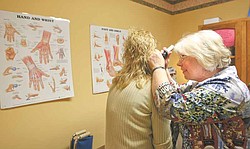Health care goes to school
The Vindicator ( Youngstown)
The Austintown Fitch High School health center is run by Janet Gorsuch, a nurse practitioner, right, who is able to perform physicals for all sports teams and administer treatments such as the flu shot for students and the community.
By Kristine Gill
AUSTINTOWN
When you have a stomachache at school, sometimes the best a school nurse can offer is an excuse to lie on a cot through geometry class.
But a nurse practitioner at a school-based health center can diagnose chronic stomach pain, prescribe medication and conduct lab testing with a guardian’s permission and even ensure that a student receives continued and affordable treatment with the right doctor.
On Monday, 20 guests from two Pennsylvania school districts and area health organizations visited Fitch High School’s school-based health center to help decide whether they could use one in their own community. Fitch’s center, which serves the entire district, is one of 20 in the state serving 50 schools, and that number is growing.
“We’ll be in 100 schools in the next six months,” said Carrie Baker, executive director for the Ohio School Based Health Care Association.
School-based health centers aim to break down barriers between students and access to health care by bringing those services to the school building. The centers are headed by a nurse practitioner who administers work and sports physicals, works closely with coaches and athletes, sees sick patients, orders prescriptions and tests for things such as strep throat, all for free or at a nominal cost. School nurses are not replaced by practitioners, but work with them.
The centers are typically funded through state grants, as is Austintown’s, awarded based on the services those centers provide to students and the community.
Baker said the first centers across the nation and in Ohio were typically found in urban areas where poor families and their children needed access to medical services the most. For schools in eastern Ohio and Appalachia, Baker said a center can help with the problem of transportation to treatment, which seems to be a main concern. Some districts even employ caseworkers to drive students to doctor appointments.
The center at Fitch employs nurse practitioner Janet Gorsuch — who also functions as school nurse — a licensed practical nurse, a secretary and two grad assistants.
Gorsuch has been at Fitch since 1994 when the school-based health center first took off. In her 15 years, Gorsuch has diagnosed diabetes, sleep apnea and thyroid disease in students. That’s more than most school nurses are trained or qualified to do.
School-based health centers often have a strong community component and offer extended hours for faculty, parents of students and area residents to take advantage of services. Barb Kliner, former treasurer for the Austintown district, said the Fitch center has a biannual event for senior citizens who can have dinner and receive a flu shot.
Susan Decker, a certified school nurse at Girard High School in Girard, Pa., said touring the facilities at Fitch and hearing from the employees was insightful.
“I think we have a better idea of how to go about this,” she said. “But it brought a lot more questions up.”
She said a changing population in her area and an increase of low-income families in the district have prompted the need for better health care for students.
“The most frustrating thing is the follow up where you see kids, and you know they need follow-up treatment, and it’s not going to happen, and you watch the conditions deteriorate,” Decker said. “Their ability to learn deteriorates.”
 43
43

